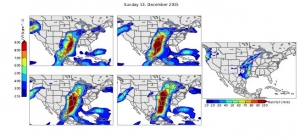February 18, 2016
by Shianne Fisher
The Mighty Mississippi swelled for weeks after record rainfall amounts swept the Midwest last December. The flooding, says one researcher at IIHR—Hydroscience & Engineering, was likely the result of a weather phenomenon known as an atmospheric river.

IIHR Researcher Gabriele Villarini instructs Iowa middle/high school teachers how to incorporate weather data into STEM curriculum at the workshop, “Hot Topic: Climate & Iowa,” in April 2015.
“Atmospheric rivers are a sort of vehicle that transports moisture and energy from the equator to the poles,” Villarini explains. “It’s one of the earth’s ways of balancing itself.” These relatively narrow bands of moisture in the lower atmosphere are more frequent when cold and hot air masses meet, especially during the winter, he says. However, atmospheric rivers (ARs) occur year-round—all over the globe, in fact—and have been responsible for significant flooding events in Iowa such as those in 1993 and 2008.
Villarini says the flooding in December was likely caused many separate ARs, which can transport an amount of water vapor more than 110 times the average flow of the Mississippi River at St. Louis. Both Iowa and Wisconsin saw their wettest Decembers ever, and 21 other states experienced above-average precipitation, leading to record flooding in many Mississippi River communities. The total damage is estimated at roughly $1 billion, and more than 50 lost their lives due to the weather.
Iowa, too, saw flood levels, prompting IFC researchers to switch the center’s stream sensors from the energy- and data-conserving “winter mode” to spring/summer sampling modes, says IIHR research engineer Dan Ceynar.
“When we look at flood events, generally we look at them as ‘all created equal,’” says Villarini. “The truth of the matter is that different floods can be associated with different flood agents. If we can understand what the drivers of flooding are, and if we can characterize the occurrence of these events, I think we are better positioned to describe flood frequency, estimate return periods, and improve flood predictability.”

The atmospheric river that resulted in record-setting flooding last December in Iowa and across the Midwest. Left: Six-hour intervals of integrated water vapor transport moving across the central United States (the redder the color, the larger the amount of moisture transported). Right: Rainfall amounts for December 13, 2015.
A Novel Concept
While the term atmospheric river, coined by two researchers at MIT in 1998, is a relatively new one, the study of the phenomenon over the Midwest is even more so.
He says continued research of the “Maya Express,” which acts in much the same way as the well-known “Pineapple Express” does on the West Coast, is crucial in understanding the role of ARs over the central United States. “We are looking at the connection between atmospheric rivers and flooding, rather than just atmospheric rivers as a meteorological phenomenon without making the connection or linking it to what happens when the rainfall hits the ground,” says Villarini.
According to research by Villarini, atmospheric rivers have caused 30–40 percent of Iowa’s largest floods in the last 30 years. Recent findings from the NASA Iowa Flood Studies (IFloodS) campaign, part of NASA’s Global Precipitation Measurement (GPM) Mission, also showed that three heavy, AR-induced rainfall events were responsible for 50 percent of the accumulated rainfall in eastern Iowa between April–June 2013. “If you can understand what’s causing nearly half of these flood events, it is a pretty good starting point,” he says.



